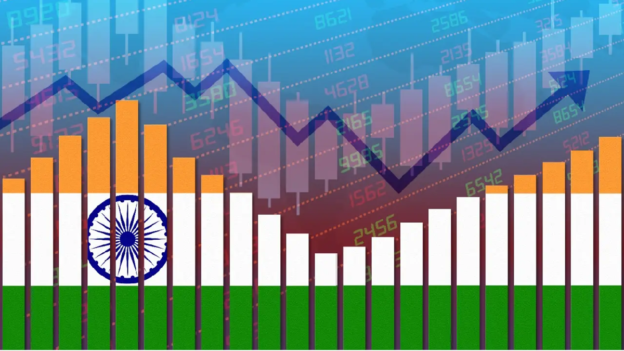IMF has warned of a possible $4 trillion loss in global economic output between now and 2026. Given the conditions within India, and globally as well, CareEdge economists expect the Indian economy to grow at 7% in FY23
Indian economy’s recovery from the coronavirus pandemic, as well as the pace of the economy is better as compared to global peers despite headwinds such as high inflation, monetary policy tightening, rising interest rate, and the Russia-Ukraine war. Recently, IMF trimmed its 2023 global economic growth forecast to 2.7%. The agency also warned of a possible $4 trillion loss in global economic output between now and 2026. Given the conditions within India, and globally as well, CareEdge economists expect the Indian economy to grow at 7% in FY23. The fiscal deficit for the current fiscal year is seen at 6.5% of GDP. The current account deficit (CAD) is projected to widen to 3.6% of GDP. RBI in its December MPC meeting is expected to hike the repo rate by 25-35 basis points (bps).
Global growth faces headwinds
IMF projects global headline CPI inflation to climb to 8.8% in 2022 from 4.7% in 2021. Inflation is projected to remain elevated but moderate to 6.5% in 2023. Additionally, the Russia-Ukraine conflict has worsened an already high inflation scenario caused by Covid-19-induced supply bottlenecks. With the pass-through of high energy costs into other prices, there is a risk of inflation becoming broad-based. Rapid monetary tightening by Central Banks and overshoot of inflation targets remain a key risk to slowing global growth, CareEdge economists noted. Global bond yields have also risen amid heightened growth concerns and monetary tightening by Central Banks. Rate hikes by central banks and strength in the US Dollar has kept the major and emerging market currencies under pressure.
The IMF has warned of stalling economic growth in the world’s three largest economies including the US, EU and China. It projects growth in global trade volume to slow sharply from 10.1% in 2021 to 4.3% in 2022 and 2.5% in 2023. The impact of the global growth slowdown on exports is already evident from the August export figures as India’s exports to the US fell to a six-month low, and exports to the EU were at the lowest level in the past nine months. In the past 12 months, India’s forex reserves have depleted by $109 billion to $532.9 billion as of 7 October 2022 RBI’s forex intervention, FII outflows and valuation loss on account of the strengthening US dollar against major currencies resulted in the fall in forex reserves.
Domestic economic signals mixed
Domestically, auto sales, E-way bills, and GST collections have shown improvement. However, consumption impulses continue to exhibit weakness. IIP consumer durables and non-durables in August 2022 were lower by 2.8% and 7.5%, respectively when compared with August 2019 (pre-pandemic period). RBI survey points to an improvement in consumer sentiment toward essential spending, while pessimism toward non-essential spending has persisted. IIP capital goods has surpassed the pre-pandemic level since June 2022 and recorded strong pre-pandemic growth of 7.9% in August. Meanwhile, capital goods imports in H1FY23 were upbeat recording a 23% growth over H1 FY20.
The seasonally adjusted capacity utilisation (manufacturing sector) rose from 73% in Q4FY22 to 74.3% in Q1FY23, its highest level in three years. Though new investment projects announced fell on a sequential and annual basis, the private sector share rose above 90% in Q1 & Q2 of the current fiscal after being range bound between 65-75% in FY22. “Rising capacity utilisation level, production and import of capital goods signal encouraging prospects for investments,” the CareEdge report said. During April-August FY23, govt’s total revenue receipts rose by 3% on the back of buoyant gross tax revenues. Revenue from major tax items also increased. So far in FY23, the Centre’s capital expenditure has risen by 46.8%, achieving 34% of the total budgeted target. The monthly average capex has been at Rs 50 crore as against the required Rs 60 crore to meet the budgeted target.
FY23 CPI inflation seen at 6.8%
Note that while retail inflation climbed back above 7% in the previous month, wholesale inflation in India dipped to the lowest level in more than a year. “This divergence in movement can be attributed to the differences in weights assigned to individual items in the CPI and WPI inflation basket,” the economists said adding that easing global commodity prices could help lower WPI inflation to single-digit in October, however, food prices are likely to be the key upside risks to CPI inflation. CareEdge economists project FY23 CPI inflation at 6.8%.
The Indian rupee is weakened considerably amid strength in US Dollar and FPI outflows pushing the currency above 82 levels. Rupee has fallen by 8.8% on a fiscal year-to-date basis, while the Dollar index has appreciated by 13.7% in the same period. Foreign Portfolio Investors have pulled out $1.2 billion so far in October after strong inflows of $7.1 billion in August. Economists at CareEdge expect USDINR to be at 81-83 by the end of FY23.
https://www.financialexpress.com/economy/india-gdp-to-grow-at-7-inflation-seen-at-6-8-in-fy23-rbi-to-hike-repo-rate-25-35-bps-in-dec-meeting/2749468/





